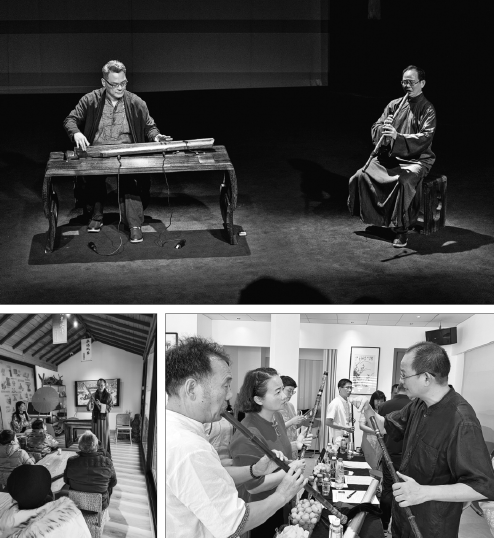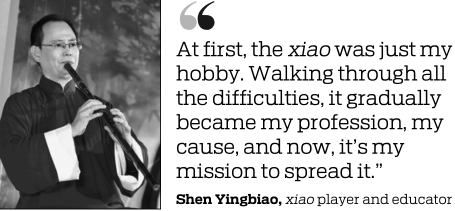Sound of the past, note for the future
Traditional bamboo flute attracts new admirers with its melodious tone, Wang Ru reports.

Often accompanying the guqin, a zither-like seven-stringed traditional musical instrument, the xiao, a traditional vertical bamboo flute with a relatively light sound, was often viewed as a foil. But with its long history and rich cultural connotations, the once-ignored instrument is now attracting more and more attention.
Shen Yingbiao is a xiao player. Although he had strong interests in musical instruments from childhood, and learned the harmonica, the erhu (two-stringed bowed instrument) and guitar when he was young, it is the xiao that has been an inseparable part of his life for decades.
Shen was infatuated with the instrument after he bought a tape of xiao music and listened to the soft, graceful and mellow sound in his hometown of Hangzhou, Zhejiang province, in 1988.
He threw himself into the world of the xiao. He spent almost a decade learning to play the instrument and polish his skills, another decade imparting them to others, and now the 53-year-old is still working to promote the instrument and its culture.
Not long after Shen was first attracted to the instrument, he decided to learn it. In the 1990s, when internet usage was not widespread in China, learning a less popular instrument was not an easy task, not least because of the scarcity of nearby teachers.
Besides teaching himself and listening to tapes to compare and improve, Shen embarked on trips to visit those who gave compelling performances he heard on tape, and received tutoring from masters in this area, such as Song Jinglian, Luo Shoucheng and Chen Hangming.
Since he had to study at school and then work to support himself, he could only undertake such trips in his spare time. As a result, the learning process spanned his 20s. "It was very tiring. Without high-speed trains, common today, I had to take a train for more than 20 hours to Beijing, or other places, to visit people. But I was resolute to take this road. I wanted to improve my skills and learn more," says Shen.
While learning the instrument, Shen was increasingly fascinated by the rich cultural connotations contained in the xiao. According to him, a scene from a TV series of a literate person piping the xiao in the moonlight, an image full of elegance and poetry, evoked his romantic imagination and has been engraved in his heart since childhood. And that reflects the close relationship between this instrument and the literate in times gone by.
In ancient China, bamboo symbolized integrity, modesty and a spirit of striving to make progress. As a result, many liked the plant and used it to refer to their pursuits in poems. For example, Song Dynasty (960-1279) poet Su Shi once wrote, "Better to eat without meat than live without bamboo", suggesting the importance of bamboo in their hearts.
Therefore, the xiao, made of bamboo, was much more than an instrument, but something they often held in hands or put on walls to remind themselves of their pursuits, and they sometimes used xiao to refer to themselves in poems as well, according to Shen.
"Since the Tang Dynasty (618-907), the xiao was often used in gatherings and meetings of the educated and literate, just like the guqin. It was so popular then that if one was not able to perform it, they were regarded as old-fashioned," says Shen.
During his learning process, Shen summarized his experience, which paved the way for his later teaching career. In 2000, with the growth of his stature, he was invited to teach dongxiao, a genre of xiao popular in the Jiangnan (south of the Yangtze River, in its lower reaches) area of China, at an art school in Hangzhou. A year later, he established the Xixi Xiao Society with his students to better promote the instrument.
Although the xiao was once popular in history, it gradually fell into oblivion. Nine major conservatories were established in the country after 1949, when the People's Republic of China was founded, but it was not included as an independent subject for music education.
"The xiao sound was too light, which weakened its expressiveness. Moreover, there was not a standard for its intonation. These all made the instrument gradually marginalized," says Shen.
"But the instrument kept its unique attractiveness, which paved the way for it to be revived. It produces heavenly music, and has a concise but profound temperament, which conforms to the traditional Chinese aesthetic idea that, 'the greatest music has the faintest notes'," he adds.
In recent years, the instrument has regained its vitality with improved tools and skills to make it, which means it can produce louder sounds now and can perform in solos. The criteria for its intonation has also been set.
"The xiao is such a good instrument. It's cheap, easy to carry, can produce gorgeous music and piping the xiao is healthy. I just cannot wait to make more people know about it," says Shen.
From his perspective, piping a xiao is also a way of cultivating yourself. "Compared with others, the xiao is an extremely simple instrument. It is only part of a bamboo with holes. Since it is so simple that you can hardly make any changes on it, you can only change yourself, like your posture and movement when piping, to make your music performance better and better," says Shen.
"It's actually an introspective process. You repeat and improve yourself, so that you are increasingly skilled, before finally you can create good music. The process is a big harvest that brings great joy," he adds.
After 40, he finally devoted himself to the cause full-time. "Before that time, the biggest difficulty for me was to strike a balance between pursuing my interest and supporting my family. I could only devote myself to it part-time to ensure my income when I was younger. But after 40, when I didn't have many economic burdens, I could wholeheartedly put myself into it," says Shen.
In 2007, the Xixi Xiao Society was renamed Qiantang (the old name of Hangzhou) Xiao Society, where people can learn to play the xiao and xiao lovers communicate with each other. In 2020, a free xiao course was started at the society, which has enabled nearly 1,000 people, especially old people who are retired, to learn the instrument, according to Shen.
Tao Xiaohong, who used to be a student of Shen, and now works as secretary-general of the Qiantang Xiao Society, says: "Shen has carried out deep research on the xiao, especially on how to show features of this old instrument in music performances. He is conscientious and unreserved in teaching, and has continued to improve it.
"It's a pity the xiao is still not as popular as we imagine now. In fact, it can produce brilliant music and touch people deeply. I agree with Shen's ideas on the xiao and would like to join his society to help him promote this instrument," she adds.
Recalling his past years, Shen says, "At first, the xiao was just my hobby. Walking through all the difficulties, it gradually became my profession, my cause, and now, it's my mission to spread it."
Ma Zhenhuan in Hangzhou contributed to this story.


Today's Top News
- China supports Ukraine peace talks between all parties
- China to hold press conference on military parade preparations
- Vast gap has to be bridged for peace to arrive in Europe
- AI powering China's industrial evolution
- Tech innovation propels nation's industrial future
- Chengdu World Games concludes amid wide acclaim





























